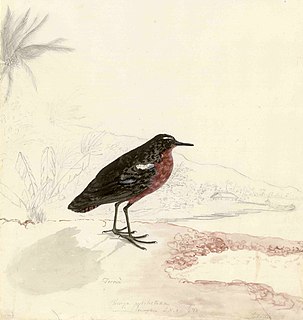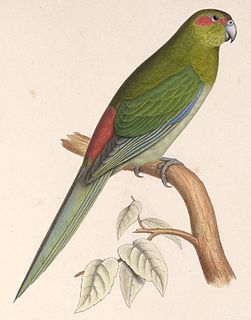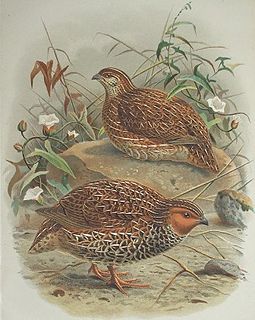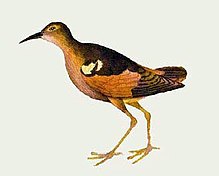
The two to five species of Polynesian sandpipers, the only members of the genus Prosobonia, are small wading birds confined to remote Pacific islands of French Polynesia. Only one species now exists, and it is rare and little known. This bird is sometimes separated in the genus Aechmorhynchus, restricting the genus to the extinct southern forms.

Moʻorea, also spelled Moorea, is a volcanic island in French Polynesia. It is one of the Windward Islands, a group that is part of the Society Islands, 17 kilometres (11 mi) northwest of Tahiti. The name comes from the Tahitian word Moʻoreʻa, meaning "yellow lizard": Moʻo = lizard ; Reʻa = yellow. An older name for the island is ʻAimeho, sometimes spelled ʻAimeo or ʻEimeo. Early Western colonists and voyagers also referred to Moʻorea as York Island or Santo Domingo.

The Tuamotu sandpiper is an endangered member of the large wader family Scolopacidae, that is endemic to the Tuamotu Islands in French Polynesia. It is sometimes placed in the monotypic genus Aechmorhynchus. A native name, apparently in the Tuamotuan language, is kivi-kivi.

The Tahiti sandpiper or Tahitian sandpiper is an extinct member of the large wader family Scolopacidae that was endemic to Tahiti in French Polynesia.
The Mauke starling or mysterious starling was a species of starling found on the island of Mauke, Cook Islands. It is now extinct. The binomen is the result of Buller's misreading of the name inornata on the specimen label. As he seems to have genuinely believed this spelling to be correct, the binomial, although it has no meaning, is valid.

The extinct black-fronted parakeet or Tahiti parakeet was endemic to the Pacific island of Tahiti. Its native name was simply ’ā’ā ("parrot") according to Latham (1790) though White (1887) gives "aa-maha".

The Tahiti rail, Tahitian red-billed rail, or Pacific red-billed rail is an extinct species of rail that lived on Tahiti. It was first recorded during James Cook's second voyage around the world (1772–1775), on which it was illustrated by Georg Forster and described by Johann Reinhold Forster. No specimens have been preserved. As well as the documentation by the Forsters, there have been claims that the bird also existed on the nearby island of Mehetia. The Tahiti rail appears to have been closely related to, and perhaps derived from, the buff-banded rail, and has also been historically confused with the Tongan subspecies of that bird.

The New Zealand quail, or koreke in Māori, is an extinct quail species endemic to New Zealand. The male and female were similar, except the female was lighter. The first scientist to describe it was Sir Joseph Banks when he visited New Zealand on James Cook's first voyage. Terrestrial and temperate, this species inhabited lowland tussock grassland and open fernlands. The first specimen to be obtained by a European was collected in 1827 by Jean René Constant Quoy and Joseph Paul Gaimard on Dumont D'Urville's voyage.

The blue-crowned lorikeet, also known as the blue-crowned lory, blue-crested lory, Solomon lory or Samoan lory, is a parrot found throughout the Lau Islands (Fiji), Tonga, Samoa, Niue and adjacent islands, including: ʻAlofi, Fotuhaʻa, Fulago, Futuna, Haʻafeva, Niuafoʻou, Moce, Niue, Ofu, Olosega, Samoa, Savaiʻi, Tafahi, Taʻu, Tofua, Tonga, Tungua, ʻUiha, ʻUpolu, Varoa, Vavaʻu, and Voleva. It is a 19 cm green lorikeet with a red throat, blue crown, and belly patch shading from red at the top to purple at the bottom.

The conquered lorikeet is a species of parrot that became extinct 700–1300 years ago. It lived in islands of Polynesia. David Steadman and Marie Zarriello wrote its species description in 1987.

The Polynesian ground dove is a critically endangered species of bird in the family Columbidae. It is endemic to the Tuamotus in French Polynesia with recent records from the atolls of Matureivavao, Rangiroa, Tenararo, Morane, Vahanga and perhaps Tikehau. It favors tropical forests, especially with Pandanus tectorius, Pisonia grandis and shrubs, but it has also been recorded from dense shrub growing below coconut palms. It is threatened by habitat loss and predation by introduced species such as cats and rats. The total population is estimated to be around 100-120 birds and it has already disappeared from several islands where it formerly occurred.

The Christmas sandpiper or Kiritimati sandpiper was a small shorebird. It became extinct some time in the first half of the 19th century. It was endemic to Christmas Island, since 1919 part of Kiribati. It is known solely from a single contemporaneous illustration, and a description by William Anderson, both made during the third circumnavigation voyage commanded by Captain James Cook, which visited the atoll of Christmas Island between 24 December 1777 and 2 January 1778.

The spotted green pigeon or Liverpool pigeon is a species of pigeon which is most likely extinct. It was first mentioned and described in 1783 by John Latham, who had seen two specimens of unknown provenance and a drawing depicting the bird. The taxonomic relationships of the bird were long obscure, and early writers suggested many different possibilities, though the idea that it was related to the Nicobar pigeon prevailed, and it was therefore placed in the same genus, Caloenas. Today, the species is only known from a specimen kept in World Museum, Liverpool. Overlooked for much of the 20th century, it was recognised as a valid extinct species by the IUCN Red List only in 2008. It may have been native to an island somewhere in the South Pacific Ocean or the Indian Ocean, and it has been suggested that a bird referred to as titi by Tahitian islanders was this bird. In 2014, a genetic study confirmed it as a distinct species related to the Nicobar pigeon, and showed that the two were the closest relatives of the extinct dodo and Rodrigues solitaire.
P. leucoptera may refer to:

The Raiatea starling, formerly known as the bay thrush, bay starling, or the mysterious bird of Ulieta, is an extinct bird species of uncertain taxonomic relationships that once lived on the island of Raiatea, the second largest of the Society Islands in French Polynesia.

The Society Islands tropical moist forests is a tropical and subtropical moist broadleaf forests ecoregion in the Society Islands of French Polynesia.














